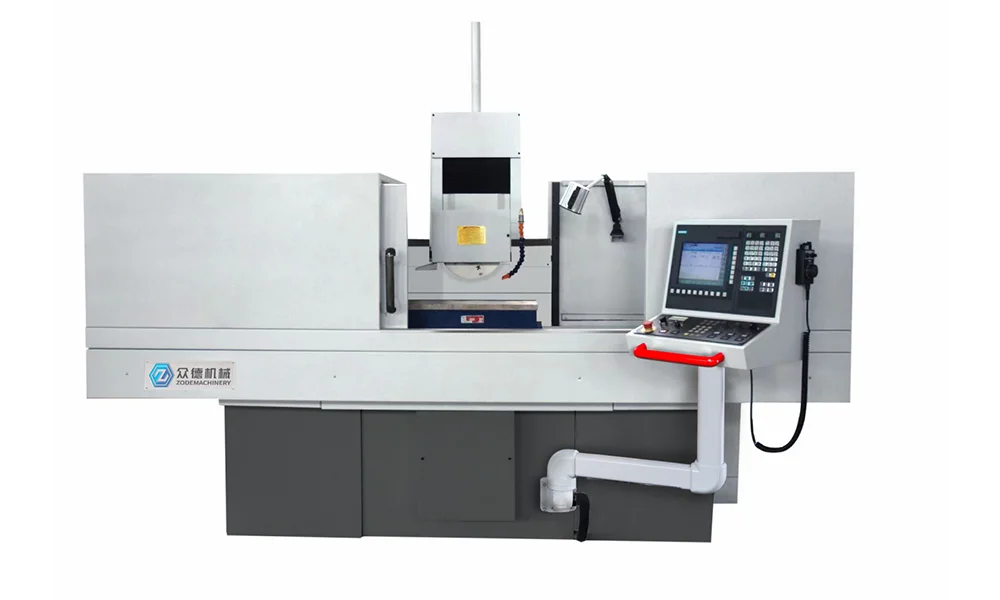- This topic is empty.
-
AuthorPosts
-
2025-05-28 at 6:20 pm #63743
Surface grinding is a critical process in many precision engineering, tool and die, and manufacturing environments. Among the various machines used, the 2 axis CNC precision surface grinding machine stands out for its balance of automation, accuracy, and user control. In this blog post, as a high performance automatic CNC surface grinder exporter, Nantong Zode will share how to use 2 axis CNC precision surface grinding machine safely.
Understanding the 2 Axis CNC Precision Surface Grinder
A 2 axis CNC surface grinder typically includes:
X-Axis (Crossfeed): Controls the movement of the grinding wheel across the workpiece.
Z-Axis (Vertical Feed): Controls the vertical movement of the wheel head.
Work Table: Moves longitudinally under the grinding head.
CNC Controller: Automates movements, grinding parameters, and sequences.
Unlike manual or semi-automatic grinders, the CNC version allows repeatable precision through programmed sequences, making it essential in industries where tolerances are measured in microns.
1. Pre-Operation Safety Measures
Before initiating any grinding work, adhere to the following essential safety checks and setups:
a) Operator Training and Certification
Only qualified and trained personnel should operate CNC grinding machinery.
Operators should be familiar with machine control systems (FANUC, Siemens, Mitsubishi, etc.), programming basics (G-code), and grinding fundamentals.
b) Personal Protective Equipment (PPE)
Always wear appropriate PPE:
Safety glasses with side shields
Hearing protection (grinding machines can exceed 90 dB)
Cut-resistant gloves when handling sharp or abrasive materials
Protective footwear with steel toe caps
Avoid loose clothing, jewelry, or long hair that can get caught in moving parts.
c) Workspace Preparation
Ensure the workspace is clean and well-lit.
Remove any unsecured tools or materials from around the grinding table.
Verify that emergency stops and safety interlocks are functional.
2. Machine Inspection and Setup
a) Visual and Functional Checks
Inspect the grinding wheel for cracks or wear. Tap test vitrified wheels before mounting.
Check coolant levels and ensure coolant nozzles are unobstructed.
Test lubrication systems and top off any reservoirs.
Confirm that axis limit switches are operational.
b) Workholding Setup
Use magnetic chucks or vacuum fixtures depending on the material.
Clean both the workpiece and the chuck surface thoroughly before mounting.
Ensure secure clamping to prevent vibration or movement during grinding.
c) Wheel Mounting and Dressing
Use appropriate wheel flanges and torque settings.
After mounting, perform a wheel balance check.
Dress the wheel using an automatic dresser or single-point diamond tool to restore shape and ensure optimal grinding conditions.
3. Programming and Loading CNC Operations
a) Inputting the Program
Use G-code or conversational programming to input grinding parameters:
Feed rates
Depth of cut
Dwell time
Passes and repetitions
Always perform a dry run without the workpiece or with the spindle off to verify movement paths and avoid collisions.
b) Setting Z-Reference and Datum
Use a touch-off gauge or indicator to set the Z-axis reference precisely.
Always zero the axis after setting reference points in the CNC controller.

4. Safe Operation Protocol
a) Initiating the Grinding Cycle
Turn on the coolant system before starting the spindle.
Gradually ramp up the spindle RPM to operating speed; typical surface grinding speeds range from 1,500 to 3,000 RPM.
Start the automated cycle through the CNC interface, monitoring for abnormalities.
b) Monitoring During Grinding
Do not leave the machine unattended during the initial passes.
Watch for signs of:
Chatter or vibration
Burn marks on the workpiece
Coolant overflow or leaks
Use a spark-out pass (non-cutting pass with wheel in contact) to improve surface finish.
c) Emergency Handling
Know the location and function of the E-stop button.
In case of wheel breakage or part ejection:
Do not open the guard until the machine has come to a full stop.
Report incidents per company safety protocols.
5. Post-Operation Procedures
a) Safe Shutdown
Return the machine axes to home or park positions.
Turn off the spindle and coolant systems.
Use a clean, lint-free cloth to wipe down exposed metal surfaces.
Leave the magnetic chuck de-energized.
b) Workpiece Handling
Wait for the part and wheel to cool before removal.
Use soft grips or lifting aids to handle heavy or delicate components.
Visually inspect the ground part for defects or dimensional inconsistencies.
6. Maintenance and Safety Best Practices
a) Daily Maintenance Checklist
Clean grinding dust from enclosures and work area.
Check coolant concentration using a refractometer.
Inspect filters and coolant delivery system.
Inspect wheel wear and redress as necessary.
b) Weekly and Monthly Maintenance
Inspect and lubricate linear guides and ball screws.
Perform vibration analysis on spindle bearings.
Calibrate Z-axis position with a dial indicator.
Back up CNC programs and parameters.
c) Safety System Tests
Regularly test interlock guards and door switches.
Check the function of overload relays and thermal cutouts.
Maintain fire extinguishers and first aid kits nearby.
7. Common Mistakes and How to Avoid Them
Mistake
Consequence
Prevention
Skipping wheel balance
Poor surface finish, chatter
Always balance after dressing
Improper clamping
Workpiece movement, damage
Verify clamping and magnetization
Incorrect feed rate
Burn marks or tool wear
Refer to material grinding specs
Insufficient coolant flow
Overheating, surface defects
Inspect and maintain coolant nozzles
Leaving machine unattended
Risk of collision or fire
Always monitor initial passes
8. Conclusion
A 2 axis CNC precision surface grinding machine offers unparalleled accuracy, repeatability, and productivity—when operated correctly. However, because of the high-speed rotation of abrasive wheels and the precision nature of the work, safety must never be compromised. Adhering to standard operating procedures, staying updated with machine technology, and enforcing a safety-first culture are essential to protecting both personnel and assets.
http://www.zodemc.com
Nantong Zode -
AuthorPosts
- You must be logged in to reply to this topic.
